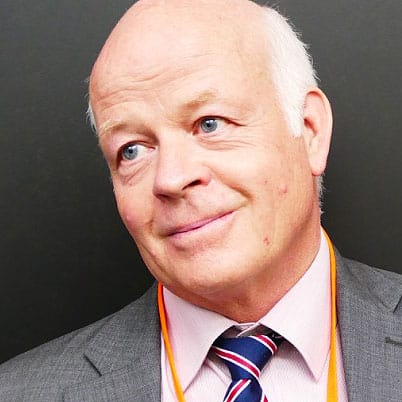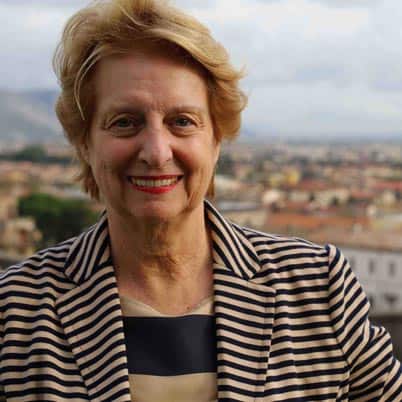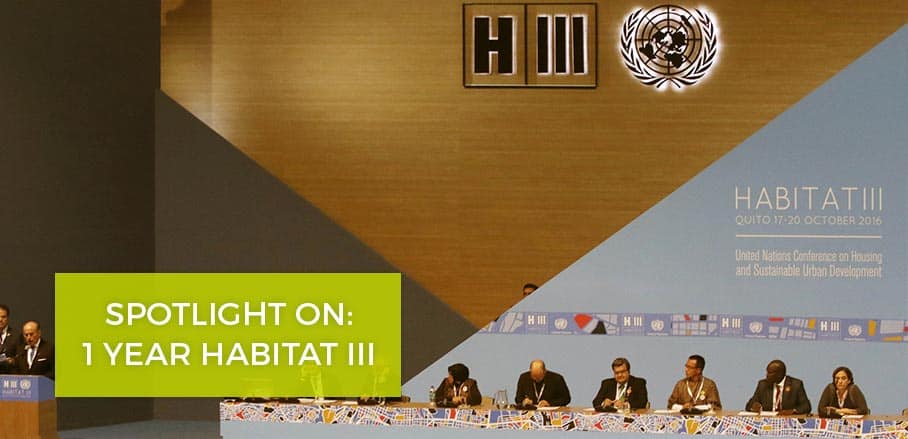Voices on 1 year New Urban Agenda
This month, the New Urban Agenda (NUA) celebrates its first anniversary. What has happened since its adoption at Habitat III in Quito? We asked Billy Cobbett (Cities Alliance), Mei Yi (Mayor of Jingdezhen, China), Eugénie L. Birch (Professor at the University of Pennsylvania), Yang Jun (Mayor of Suzhouto), María Alejandra Vicuña Muñoz (Minister of Urban Development and Housing of Ecuador) to take stock of the past 12 months’ implementation actions. Read the interviews below!

Q: What has been achieved since the adoption of the New Urban Agenda in Quito in 2016?
Quite simply, not nearly enough. We look at the New Urban Agenda as an important dimension of the most comprehensive global development package, spearheaded by the 2030 Agenda for Sustainable Development. Collectively, these global agreements present a bold and visionary agenda that – if implemented – have both the breadth and the scale to resolve the most important challenges facing humanity.
While there was generally significant enthusiasm for the new agreements, there has been limited progress in the two years since the adoption of the Sustainable Development Goals (SDGs) and the Paris Climate Agreement, and in the year since the adoption of the New Urban Agenda (NUA). However, as with the Millennium Development Goals (MDGs), we saw that targets were achieved very unevenly, with much of the burden being carried by dynamic economies in East Asia. What is already very apparent, particularly in respect of the climate change context, is that we are seeing remarkable innovations in technology and energy, with an interesting combination of new economies and, most encouragingly, sub-national governments and cities playing a leadership role where national governments falter.
Q: What are the main bottlenecks regarding the implementation of the New Urban Agenda?
This is much bigger than the New Urban Agenda.
While there are always different reasons for lack of progress, the starting point is generally a lack of the political will needed to give operational meaning to political agreements. Certainly, in part this has been influenced by changes of government, which have also led to some retreats from previously agreed positions. The second observation is that, if we look at the experience of the MDGs, it took a number of years before implementation reached scale, and – given the additional complexity and scope of the post-2015 settlement – this can also partially explain lack of progress.
However, there is little doubt that, in addition to weak political will and a lack of leadership, the developmental agenda has been diverted by the resources expended on long-running wars and conflict; on a disregard for human rights in general, and for the poor in particular (such as the return to mass, forced evictions); on humanitarian and migrant crises and on a dangerous retreat from multilateral action. In this context, there is a new importance and urgency to ensure that reforms to the UN system are both timely and bold enough to re-establish the legitimacy of the one global system that we have.
Q: What needs to be done to overcome those bottlenecks?
The New Urban Agenda is a very useful guide to some of the urban actions needed to support the implementation of the 2030 Agenda for Sustainable Development. In the first instance, we do know what works well, based on decades and even centuries of experience – effective, transparent and accountable governance; an unwavering respect for human rights; active steps to promote gender equality and the empowerment of women; the impartial application of the rule of law; the certainty of sanction, and zero tolerance for corruption.
Additionally, implementation will require new thinking, new relationships and new behaviour. In the first instance, many national governments need to start treating sub-national governments as part of a single, integrated national system of governance, each with specific and complementary roles and competencies. Secondly, mayors and local governments urgently need to establish new relations with the whole city, and with all citizens. This includes both individual citizens, as well as corporate citizens and the private sector, including those engaged in the informal economy. Finally, all actors need to promote programmatic, long-term and consistent approaches to development, and stop looking for short-term fixes.

Q: What has been achieved since the adoption of the New Urban Agenda in Quito in 2016?
While we are witnessing a continuous increase in the urbanisation rate, it is a positive development that the perspectives of liveability, ecology and sustainability become more prominent and important in global discussions on the future of urban development. When we look more closely to our cities, it is also recognizable that the focus increasingly shifts from creating new quarters to retrofitting and upgrading existing structures.
Q: What are the main bottlenecks regarding the implementation of the New Urban Agenda?
Countries all over the world are presently in different phases of development, hence they also encounter different challenges. The problems that developing countries are currently confronted with should be better understood. Only then can developed countries give more constructive support and contributions.
Q: What needs to be done to overcome those bottlenecks?
For successful implementation, better mutual learning and support between countries needs to be encouraged. Also, the developed countries could bare more responsibilities within their capacity. We should all be contributing to our common future.

Q: What has been achieved since the adoption of the New Urban Agenda in Quito in 2016?
Since Quito, the UN General Assembly has adopted the New Urban Agenda (NUA) in December 2016, and civil society organisations such as the General Assembly of Partners (GAP) have redirected their attention to its implementation. Each of the 16 GAP Partner Constituency Groups is now developing a strategic framework for NUA implementation at the global and local levels. From the UN perspective, the mandated independent report and high-level meeting on NUA implementation and the effectiveness of UN-Habitat have been successfully concluded, readying the scene for an upcoming resolution on the topics. The World Urban Forum 9 is in train to serve as an arena for NUA discussions as well as for preparations for the review of SDG 11 next July and the quadrennial report.
Q: What are the main bottlenecks regarding the implementation of the New Urban Agenda?
The principle bottleneck – which I would call a challenge – is localising the NUA implementation at the national and subnational levels. This is an issue with all the recently developed global agreements such as the Sendai Framework and the 2030 Agenda.
Aligning the agreements, which may require some structural adjustments or re-allocation of resources, will take some work over time. We must remember that the agreements are in place for 15 or 20 years, so developing patient, steady attention among all parties is another challenge.
Q: What needs to be done to overcome those bottlenecks?
Broad scale education, strategic thinking, and arranging many collaborative discussions among government and stakeholders will contribute to the alignment and implementation of the global agreements at the local levels. Of great importance will be the development of contextually relevant multi-stakeholder partnerships, a time-consuming but essential process. Energising and renewing the required leadership and dedication to the principles and values of the agreements can occur through on-going global conventions, innovative communication strategies and accessible publications to share evidence-based knowledge and practices. This later type of exchange should be analytical and identify critical success factors and potential barriers to replication.

Q: What has been achieved since the adoption of the New Urban Agenda in Quito in 2016?
It is great to see that urban planning is taking a more systematic and integrated approach. Progress is being made in terms of better inclusiveness in urban development, for example regarding improved public service. The same goes for a strengthened emphasis on ecological perspectives, for example in the fields of waste management and air quality.
Q: What are the main bottlenecks regarding the implementation of the New Urban Agenda?
Concerning the situation in China, there are not enough technical approaches and options available for effective and large-scale environmental protection. Generally speaking, we need better digital administrative management tools for municipalities and urban communities. We also need to better understand the different patterns of migration and need more information on its impacts on urban development.
Q: What needs to be done to overcome those bottlenecks?
What we need is in-depth research, learning from best practices all over the world, and applying the proven experiences in on-the-ground projects in Chinese cities.

Q: What has been achieved since the adoption of the New Urban Agenda in Quito in 2016?
Since the adoption of the NUA, a draft of the National Urban Agenda (Agenda Urbana Nacional – AUN) has been prepared in Ecuador with the support of UN-Habitat. The main objective of the AUN is to achieve more equitable, sustainable and productive human settlements and cities where all people, both present and future generations, can enjoy equal rights and opportunities without discrimination of any kind in order to promote prosperity and quality of life for all.
The pillars of our Agenda for a sustainable and resilient habitat are Equitable Cities, Productive Cities, Sustainable and Resilient Cities and the Recovery of the Public Sphere.
Q: What are the main bottlenecks regarding the implementation of the New Urban Agenda?
We have identified many opportunities and challenges with respect to the implementation of the NUA. One of them is the formulation of a National Urban Policy (Política Urbana Nacional – PUN) that promotes the development of cities and human settlements. Without an appropriate PUN, cities face multiple risks such as saturated and inadequate infrastructure, incompatible or underutilised land, competition between neighbouring cities widening the gap of inequalities and spatial segregation, etc.
In addition, there must be an Urban Legislation to regulate land management policies and urban development strategies. If cities do not have this legal framework, they face multiple risks such as urban sprawl, loss of agricultural land and lack of environmental protection, increase in inequality gaps, as well as poor and inappropriate land management.
Another important factor is Urban Planning in order to optimise the spatial dimension through development plans, ordinances and urban design processes of cities. It is important to emphasise that if there is no planning, cities will show low indices of habitability, they will be unsuitable for pedestrians disconnecting them from the urban fabric, hence resulting in poor public space quality, inequality and spatial segregation.
The Urban Economy and Municipal Finance should also be considered to reduce inequality and exclusion. It is necessary to provide technical assistance to local governments in order to promote access to financing sources for urban development and land management. This will help to strengthen the municipal economy and reduce the fiscal dependence on the central government.
Q: What needs to be done to overcome those bottlenecks?
The actions necessary to overcome those challenges and implement the NUA include National Urban Policies (PUN), which establish national norms and ordinances related to soil capacities, urban development, environmental and heritage protection, and reduction of risks to natural disasters. In this way, sustainable and resilient cities can be planned while taking into account the distribution of and equitable access to urbanised land.
In addition, a conceptual framework should be adopted to reduce territorial inequalities through PUN in order to promote inclusion and productive systems in cities and human settlements and to strengthen rural-urban linkages.
Urban Legislation and Regulation will allow to improve land use and land management, financing of urban development, and precise projections of the real growth of the urban space.
Urban Planning and Design will provide projections on population growth and demographic changes, as well as identify job opportunities and possible natural and anthropogenic threats that could affect urban and territorial development. This adds to promoting sustainable densities and mixed uses to achieve economies of agglomeration through housing in proximity to workplaces, public services and integrated transport systems.
